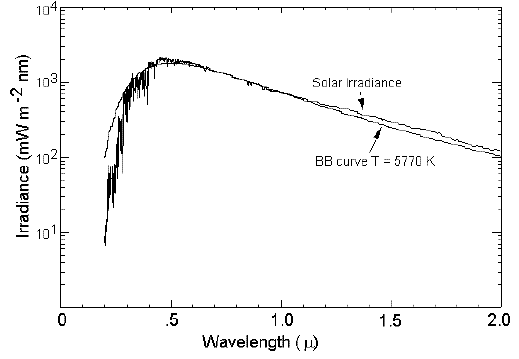
Abstract The solar spectrum peaks in the visible and is well represented as a black-body spectrum with an effective temperature near 6000 K. As we move from visible to ultraviolet wavelengths the radiation originates higher in the solar atmosphere: radiation at 400 nm originates near the base of the solar photosphere, at 200 nm near the top of the photosphere, from 100 to 160 nm from the chromosphere, and less than 100 nm from the transition region and corona. Examining radiation from higher and higher layers of the solar atmosphere, the variation steadily increases from far less than 1% at wavelengths longward of 300 nm, 10's of percent from 100 to 200 nm, and exceeding an order of magnitude at the short EUV and X-ray wavelengths. Such variability is now documented over all time scales: short- to intermediate-term variations, usually associated with the appearance and disappearance of active regions and modulated by the 27-day rotation of the Sun, to the much longer 11-year solar cycle variations.

FIGURE 1: The solar irradiance spectrum from 0.2 µm to 2 µm. The smooth curve superposed is a black-body spectrum with an effective temperature of 5770 K.
When the Sun is observed from the ground, roughly half of the radiation has already been absorbed or scattered away by the atmosphere. Ozone is completely effective in removing all radiation short of 300 nm, and longward of about 1 µm large segments of the spectrum are removed by atmospheric water vapor. These and other absorbers, coupled with clouds and aerosols, are quite variable and preclude any hope of detecting from the ground changes in solar radiation unless the variation is quite large - say on the order of several percent. It is for these reasons that early attempts to establish solar variability were quite unsuccessful, and it was only with the advent of long-duration space missions that the first true measures of solar variability have now been achieved. Measurements from several spacecraft now span almost two complete solar cycles and from these we infer that the total solar irradiance, at least for the two most recent solar cycles, only changes on the order of 0.1%, certainly with some shorter term variations of a few times this value. The reader is referred to the observations that have been reported for the ERB instrument on NIMBUS-7 (Kyle at al., 1993), the ACRIM instruments on SMM and UARS (Willson, 1994), the ERBS instrument on the ERBE satellite (Lee, 1995), the VIRGO instrument on SOHO (Frö hlich, 1994), and several others.
For this discussion we will consider the record of total solar irradiance (TSI) only in the context of its constraint on the spectral measurements at ultraviolet wavelengths. That is, if we consider that the TSI varies by 0.1% we infer that the spectral band short of 400 nm, about 10% of TSI, cannot vary by more that 1% - or it would account for the entirety of the TSI variation. Likewise the band short of 300 nm, about 1% of TSI, cannot vary more than 10%. The following discussion will carefully consider what we presently know about the variation of the Sun in the ultraviolet, and what is yet to be measured and learned.